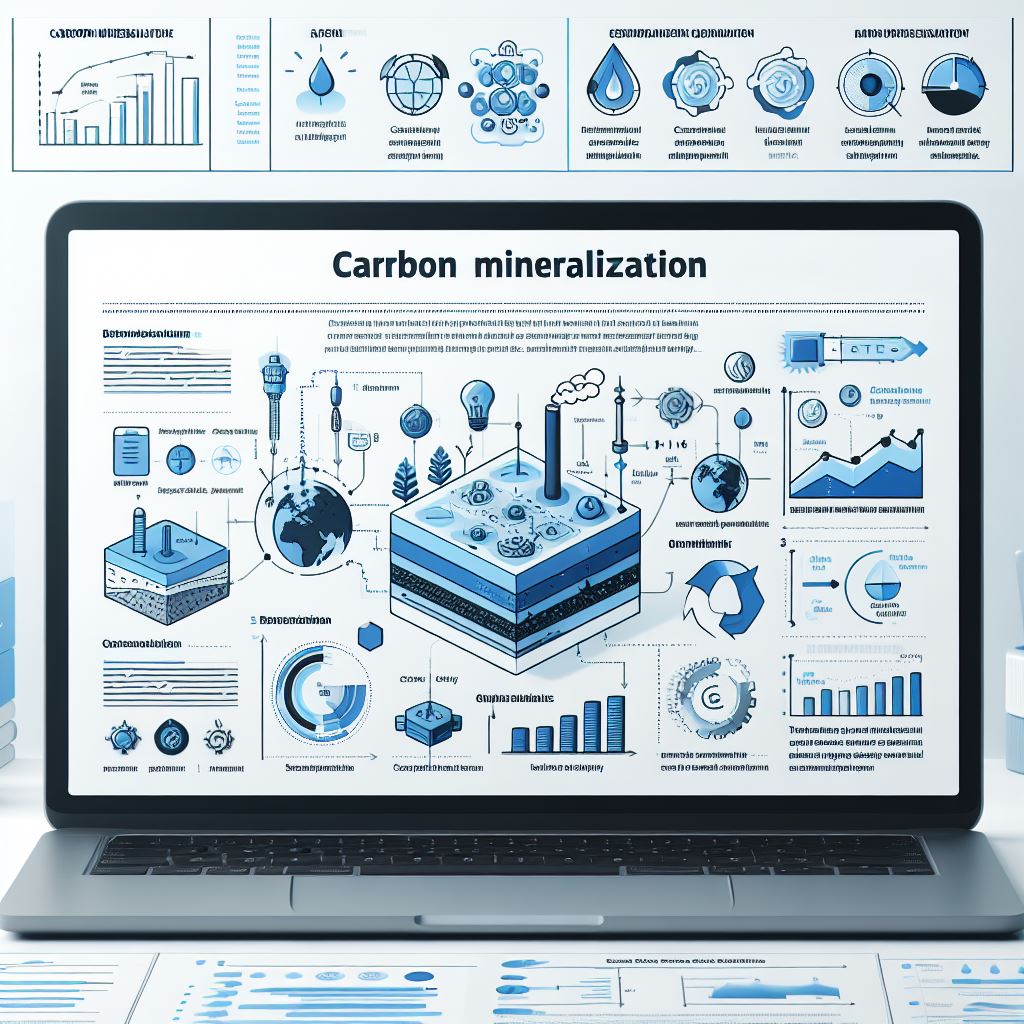Remarks: This text was created with a universal free text search string using ChatGPT-4 via Bing. Only some small manual changes, setting links, and optimizations had been necessary. This AI created text is providing more information about a specific one from the technologies to reduce greenhouse gas emissions, i.e., the carbon mineralization.
Introduction
Carbon dioxide (CO2) is a greenhouse gas that contributes to global warming and climate change. The concentration of CO2 in the atmosphere has been increasing since the industrial revolution, primarily due to human activities such as burning fossil fuels, deforestation, and land-use changes. To mitigate the effects of climate change, it is essential to reduce greenhouse gas emissions and remove CO2 from the atmosphere. Carbon mineralization is a promising carbon removal strategy that can accelerate the natural process of CO2 removal from the atmosphere. This article provides an overview of carbon mineralization, its benefits, and limitations.
What is Carbon Mineralization?
Carbon mineralization is a process that occurs naturally over hundreds or thousands of years, in which certain minerals inside rocks react with atmospheric CO2 to create carbonates, solid minerals that securely remove and sequester CO2 ¹. This chemical reaction works best with mafic or ultramafic rocks, which are highly reactive to CO2. They contain alkaline minerals like magnesium or calcium-bearing silicates ¹. Through these natural sink processes, carbon mineralization permanently removes about 0.3 billion metric tons (gigatons) of CO2 from the atmosphere each year, which is a little more than Poland’s annual emissions ¹.
How Does Carbon Mineralization Work?
Carbon mineralization accelerates the natural process of CO2 removal from the atmosphere by speeding up the reactions between CO2 and certain minerals ¹. This process can be sped up in numerous ways to remove large amounts of atmospheric CO2 in the coming decades ¹. The most common method of carbon mineralization is to grind up mafic or ultramafic rocks into small particles and spread them over large areas of land ¹. The CO2 in the atmosphere reacts with the alkaline minerals in the rocks, forming carbonates that are stable and do not release CO2 back into the atmosphere ¹. This process is also known as enhanced weathering ¹.
Benefits of Carbon Mineralization
Carbon mineralization presents significant carbon removal potential and can help mitigate the effects of climate change ¹. It is a natural process that has been occurring for millions of years and is safe for the environment ¹. Carbon mineralization can also be used to restore degraded lands and improve soil quality ¹. The process can also be used to produce construction materials like concrete, which can store CO2 for centuries ¹. Carbon mineralization can also be used to treat mine tailings and other industrial waste, reducing the environmental impact of these materials ¹.
Limitations of Carbon Mineralization
Carbon mineralization is a slow process that requires large amounts of rock and land to be effective ¹. The process is also energy-intensive, requiring significant amounts of energy to grind up the rocks and transport them to the desired location ¹. Carbon mineralization is also limited by the availability of suitable rocks. They are not found in all regions of the world ¹. The process can also have unintended environmental consequences, such as altering the pH of the soil and affecting the growth of plants ¹. More research is needed to better understand the environmental and social impacts of carbon mineralization.
Case Studies
Carbon mineralization has been used in several pilot projects around the world to test its effectiveness as a carbon removal strategy. In Iceland, researchers have been injecting CO2 into basaltic rocks, which react with the CO2 to form carbonates ⁴. The process is safe and has the potential to remove significant amounts of CO2 from the atmosphere ⁴. In Canada, researchers have been testing the use of mine tailings to remove CO2 from the atmosphere ². The process has been successful in laboratory tests and has the potential to be scaled up to remove large amounts of CO2 ².
Conclusion
Carbon mineralization is a promising carbon removal strategy that can help mitigate the effects of climate change. The process accelerates the natural process of CO2 removal from the atmosphere and can be used to restore degraded lands, produce construction materials, and treat industrial waste. However, the process is slow and energy-intensive and requires large amounts of rock and land to be effective. More research is needed to better understand the environmental and social impacts of carbon mineralization. Despite its limitations, carbon mineralization presents significant carbon removal potential. It should be considered as part of a comprehensive strategy to reduce greenhouse gas emissions and mitigate the effects of climate change.
References
(1) What is Carbon Mineralization? | World Resources Institute. https://www.wri.org/insights/carbon-mineralization-carbon-removal.
(2) Setting carbon management in stone – MIT News. https://news.mit.edu/2022/setting-carbon-management-stone-0317.
(3) Making Minerals-How Growing Rocks Can Help Reduce Carbon Emissions. https://www.usgs.gov/news/featured-story/making-minerals-how-growing-rocks-can-help-reduce-carbon-emissions.
(4) The Advanced Carbon Mineralization Initiative – MIT Climate Grand …. https://climategrandchallenges.mit.edu/research/catalyzing-geological-carbon-mineralization/.
(5) Carbon mineralization pathways for carbon capture, storage and utilization. https://www.nature.com/articles/s42004-021-00461-x.pdf.
(6) What Is Carbon Mineralization? | Patch. https://www.patch.io/blog/carbon-mineralization.
(7) What is Carbon Mineralization? – Biorecro. https://www.biorecro.com/carbon-mineralization/.
My Source: Chat with Bing Copilot i.e., ChatGPT-4, 12.1.2024
Link to the universal AI Search String for Copilot
My comment: The text above seems to be valid, it provides an overview. When checking the result against the universal search string, you can see that it reflects only a few aspects of the tasks for AI. To the result: It is unusual to use only one source for more than half of the text. Only 4 of the 7 citations are used at all. Source 5 is the scientific one, I think it’s suitable for “further reading”. The summary starts with my take home message:
Despite the advancements made in producing Ca- and Mg-
Greeshma Gadikota, https://doi.org/10.1038/s42004-021-00461-x
bearing carbonates from anthropogenic CO2, several scientific
challenges remain.





Heute bei DW gelesen: Eine Sanford Underground Research Facility, offensichtlich auf dem Gelände einer ehemaligen Goldmine in South Dakota, berichtet von extremophilen Bakterien tief in der Erde. Diese seien in der Lage, innerhalb von 10 Tagen MgCO3, also Magnesit, unter bestimmten physikalischen Bedingungen zu Gestein umzuwandeln und damit CO2 dauerhaft zu binden. Das sei eine Art Meilenstein der Carbon Mineralization. Ich würde sagen, dass das spannend klingt. Aber mehr als eine Versuchskonstellation dürfte das noch nicht sein. 500 Bar Druck, 80 °C, 1000 Meter Tiefe und Verwendung von MgCo3 sind schon speziell. Ich lese nichts von einer Energiebilanz des Prozesses.
Eben gefunden: Die Helmholtz Klimainitiative berichtet am 1.2.2024 unter Aktuelles über die „Entnahme von CO2 als Baustein der deutschen Klimapolitik„. Offensichtlich gibt es bereits mehrere solche Projekte sogar in Deutschland, die teilweise schon länger erfolgreich im Einsatz sind. Hier der Link zum PDF-Dokument.
Die taz berichtet gestern in einem kurzen Artikel von der aktuellen Ablehnung der CCS-Technologie durch verschiedene Umweltverbände. Diese sei das Gegenteil von Umweltschutz. Sie berge verschiedene Risiken, die sich durch den Energiebedarf und die Lagerung ergeben.